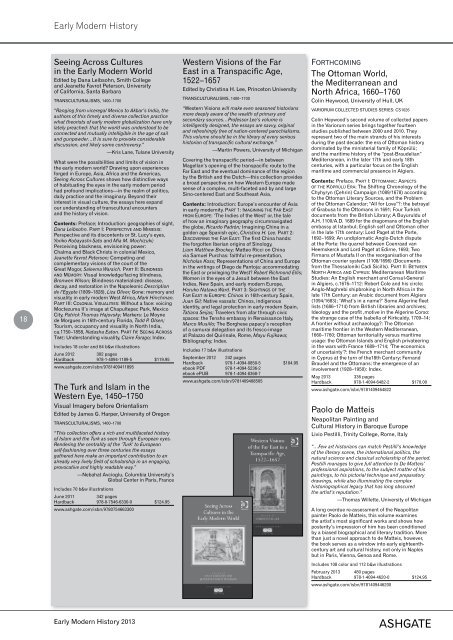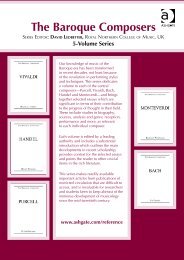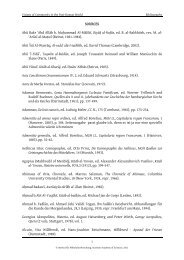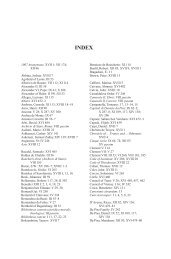Early Modern History - Ashgate
Early Modern History - Ashgate
Early Modern History - Ashgate
You also want an ePaper? Increase the reach of your titles
YUMPU automatically turns print PDFs into web optimized ePapers that Google loves.
18<br />
<strong>Early</strong> <strong>Modern</strong> <strong>History</strong><br />
Seeing Across Cultures<br />
in the <strong>Early</strong> <strong>Modern</strong> World<br />
Edited by Dana Leibsohn, Smith College<br />
and Jeanette Favrot Peterson, University<br />
of California, Santa Barbara<br />
TrANSCULTUrALISMS, 1400–1700<br />
“Ranging from viceregal Mexico to Akbar’s India, the<br />
authors of this timely and diverse collection practice<br />
what theorists of early modern globalization have only<br />
lately preached: that the world was understood to be<br />
connected and mutually intelligible in the age of sail<br />
and gunpowder…It is sure to provoke considerable<br />
discussion, and likely some controversy.”<br />
—Kris Lane, Tulane University<br />
What were the possibilities and limits of vision in<br />
the early modern world? Drawing upon experiences<br />
forged in Europe, Asia, Africa and the Americas,<br />
Seeing Across Cultures shows how distinctive ways<br />
of habituating the eyes in the early modern period<br />
had profound implications—in the realm of politics,<br />
daily practice and the imaginary. Beyond their<br />
interest in visual culture, the essays here expand<br />
our understanding of transcultural encounters<br />
and the history of vision.<br />
Contents: Preface; Introduction: geographies of sight,<br />
Dana Leibsohn. Part I: PersPeCtIve and mImesIs:<br />
Perspective and its discontents or St. Lucy’s eyes,<br />
Yoriko Kobayashi-Sato and Mia M. Mochizuki;<br />
Perceiving blackness, envisioning power:<br />
Chalma and Black Christs in colonial Mexico,<br />
Jeanette Favrot Peterson; Competing and<br />
complementary visions of the court of the<br />
Great Mogor, Saleema Waraich. Part II: blIndness<br />
and memory: Visual knowledge/facing blindness,<br />
Bronwen Wilson; Blindness materialized: disease,<br />
decay, and restoration in the Napoleonic Description<br />
de l’Egypte (1809–1828), Liza Oliver; Gone: memory and<br />
visuality in early modern West Africa, Mark Hinchman.<br />
Part III: ColonIal vIsualItIes: Without a face: voicing<br />
Moctezuma II’s image at Chapultepec Park, Mexico<br />
City, Patrick Thomas Hajovsky; Markers: Le Moyne<br />
de Morgues in 16th-century Florida, Todd P. Olsen;<br />
Tourism, occupancy and visuality in North India,<br />
ca.1750–1858, Natasha Eaton. Part Iv: seeIng aCross<br />
tIme: Understanding visuality, Claire Farago; Index.<br />
Includes 18 color and 64 b&w illustrations<br />
June 2012 302 pages<br />
Hardback 978-1-4094-1189-5 $119.95<br />
www.ashgate.com/isbn/9781409411895<br />
The Turk and Islam in the<br />
Western Eye, 1450–1750<br />
Visual Imagery before Orientalism<br />
Edited by James G. Harper, University of Oregon<br />
TrANSCULTUrALISMS, 1400–1700<br />
“This collection offers a rich and multifaceted history<br />
of Islam and the Turk as seen through European eyes.<br />
Rendering the centrality of the ‘Turk’ to European<br />
self-fashioning over three centuries the essays<br />
gathered here make an important contribution to an<br />
already very lively field of scholarship in an engaging,<br />
provocative and highly readable way.”<br />
—Nebahat Avcioglu, Columbia University’s<br />
Global Center in Paris, France<br />
Includes 70 b&w illustrations<br />
June 2011 342 pages<br />
Hardback 978-0-7546-6330-0 $124.95<br />
www.ashgate.com/isbn/9780754663300<br />
<strong>Early</strong> <strong>Modern</strong> <strong>History</strong> 2013<br />
Western Visions of the Far<br />
East in a Transpacific Age,<br />
1522–1657<br />
Edited by Christina H. Lee, Princeton University<br />
TrANSCULTUrALISMS, 1400–1700<br />
“Western Visions will make even seasoned historians<br />
more deeply aware of the wealth of primary and<br />
secondary sources…Professor Lee’s volume is<br />
intelligently designed, the essays are savvy, original<br />
and refreshingly free of nation-centered parochialisms.<br />
This volume should be in the library of every serious<br />
historian of transpacific cultural exchange.”<br />
—Martin Powers, University of Michigan<br />
Covering the transpacific period—in between<br />
Magellan’s opening of the transpacific route to the<br />
Far East and the eventual dominance of the region<br />
by the British and the Dutch—this collection provides<br />
a broad perspective on how Western Europe made<br />
sense of a complex, multi-faceted and by and large<br />
Sino-centered East and Southeast Asia.<br />
Contents: Introduction: Europe’s encounter of Asia<br />
in early modernity. Part 1: ImagInIng the far east<br />
from euroPe: ‘The Indies of the West’ or, the tale<br />
of how an imaginary geography circumnavigated<br />
the globe, Ricardo Padrón; Imagining China in a<br />
golden age Spanish epic, Christina H. Lee. Part 2:<br />
dIsCoverIng the far east: The first China hands:<br />
the forgotten Iberian origins of Sinology,<br />
Liam Matthew Brockey; Matteo ricci on China<br />
via Samuel Purchas: faithful re-presentation,<br />
Nicholas Koss; representations of China and Europe<br />
in the writings of Diego de Pantoja: accommodating<br />
the East or privileging the West? Robert Richmond Ellis;<br />
Women in the eyes of a Jesuit between the East<br />
Indies, New Spain, and early modern Europe,<br />
Haruko Natawa Ward. Part 3: sIghtIngs of the<br />
far east In euroPe: Chinos in 16th-century Spain,<br />
Juan Gil; Native vassals: Chinos, indigenous<br />
identity, and legal protection in early modern Spain,<br />
Tatiana Seijas; Travelers from afar through civic<br />
spaces: the Tensho embassy in renaissance Italy,<br />
Marco Musillo; The Borghese papacy’s reception<br />
of a samurai delegation and its fresco-image<br />
at Palazzo del Quirinale, rome, Mayu Fujikawa;<br />
Bibliography; Index.<br />
Includes 17 b&w illustrations<br />
September 2012 242 pages<br />
Hardback 978-1-4094-0850-5 $104.95<br />
ebook PDF 978-1-4094-5236-2<br />
ebook ePUB 978-1-4094-8368-7<br />
www.ashgate.com/isbn/9781409408505<br />
forthComIng<br />
The Ottoman World,<br />
the Mediterranean and<br />
North Africa, 1660–1760<br />
Colin Heywood, University of Hull, UK<br />
VArIOrUM COLLECTED STUDIES SErIES: CS1026<br />
Colin Heywood’s second volume of collected papers<br />
in the Variorum series brings together fourteen<br />
studies published between 2000 and 2010. They<br />
represent two of the main strands of his interests<br />
during the past decade: the era of Ottoman history<br />
dominated by the ministerial family of Köprülü;<br />
and the maritime history of the “post-Braudelian”<br />
Mediterranean, in the later 17th and early 18th<br />
centuries, with a particular focus on the English<br />
maritime and commercial presence in Algiers.<br />
Contents: Preface. Part I: ottomanIC: asPeCts<br />
of the köPrülü era: The Shifting Chronology of the<br />
Chyhyryn (Çehrin) Campaign (1089/1678) according<br />
to the Ottoman Literary Sources, and the Problem<br />
of the Ottoman Calendar; “All for Love”?: the betrayal<br />
of Grabusa to the Ottomans in 1691; Four Turkish<br />
documents from the British Library; A Buyuruldu of<br />
A.H. 1100/A.D. 1689 for the dragomans of the English<br />
embassy at Istanbul; English self and Ottoman other<br />
in the late 17th century: Lord Paget at the Porte,<br />
1692–1699; An undiplomatic Anglo-Dutch dispute<br />
at the Porte: the quarrel between Coenraad van<br />
Heemskerck and Lord Paget at Edirne, 1693; Two<br />
Firmans of Mustafa II on the reorganisation of the<br />
Ottoman courier system (1108/1696) (Documents<br />
from the Thessaloniki Cadi Sicills). Part II: between<br />
north afrICa and CyPrus: Mediterranean Maritime<br />
Studies: An English merchant and Consul-General<br />
in Algiers, c.1676–1712: robert Cole and his circle;<br />
Anglo-Maghrebi shipbroking in North Africa in the<br />
late 17th Century: an Arabic document from Algiers<br />
(1094/1683); ‘What’s in a name?’ Some Algerine fleet<br />
lists (1686–1714) from British libraries and archives;<br />
Ideology and the profit ,motive in the Algerine Corso:<br />
the strange case of the Isabella of Kirkcaldy, 1709–14;<br />
A frontier without archaeology?: The Ottoman<br />
maritime frontier in the Western Mediterranean,<br />
1660–1760; Ottoman territoriality versus maritime<br />
usage: the Ottoman Islands and English privateering<br />
in the wars with France 1689–1714; ‘The economics<br />
of uncertainty’?: the French merchant community<br />
in Cyprus at the turn of the18th Century; Fernand<br />
Braudel and the Ottomans: the emergence of an<br />
involvement (1928–1950): Index.<br />
May 2013 336 pages<br />
Hardback 978-1-4094-6482-2 $170.00<br />
www.ashgate.com/isbn/9781409464822<br />
Paolo de Matteis<br />
Neapolitan Painting and<br />
Cultural <strong>History</strong> in Baroque Europe<br />
Livio Pestilli, Trinity College, rome, Italy<br />
“…Few art historians can match Pestilli’s knowledge<br />
of the literary scene, the international politics, the<br />
natural science and classical scholarship of the period.<br />
Pestilli manages to give full attention to De Matteis’<br />
professional aspirations, to the subject matter of his<br />
paintings, to his pictorial technique and preparatory<br />
drawings, while also illuminating the complex<br />
historiographical legacy that has long obscured<br />
the artist’s reputation.”<br />
—Thomas Willette, University of Michigan<br />
A long overdue re-assessment of the Neapolitan<br />
painter Paolo de Matteis, this volume examines<br />
the artist’s most significant works and shows how<br />
posterity’s impression of him has been conditioned<br />
by a biased biographical and literary tradition. More<br />
than just a novel approach to de Matteis, however,<br />
the book serves as a window into early eighteenthcentury<br />
art and cultural history, not only in Naples<br />
but in Paris, Vienna, Genoa and rome.<br />
Includes 108 color and 112 b&w illustrations<br />
February 2013 480 pages<br />
Hardback 978-1-4094-4620-0 $124.95<br />
www.ashgate.com/isbn/9781409446200<br />
ASHGATE





